La Trobe University Sculpture Park (Bundoora)

The La Trobe University Sculpture Park is nestled in the beautiful bushland setting of the University's Melbourne campus, and features works from every decade since the establishment of the University in the mid-1960s. The collection reflects key movements and trends in contemporary Australian sculpture, including pieces by Inge King, Robert Klippel, Leonard French, Karen Ward and Reko Rennie.
Australian sculpture was an integral part of the original design and Master Plan of the Melbourne, Bundoora campus. The works installed in the grounds complement the architecture, lively population, flora and extensive wildlife that form the much admired landscape of the campus. Explore our large grounds and meditative gardens all year round, to discover, contemplate and enjoy this important collection of sculptures.
Opening Hours:
The La Trobe University grounds are open all year round to the public.
Cost:
Free
Review:
A really good collection of outdoor sculpture which is well worth a visit. The highlight for us was the rhino sculpture 'Run for your life' which is awesome. You can even take a ride on one of the rhinos with the iconic hybrid dogman and rabbitgirl characters of Australian artists Gillie and Marc. Dante's Divine Comedy is also another spectacular and detailed sculpture.
We found it best to go on the weekend when the car parking is free and there are few students.
The current works in the sculpture park are (numbers refer to the locations on the downloadable map)
#1 Landmark by Charles Robb (2004)
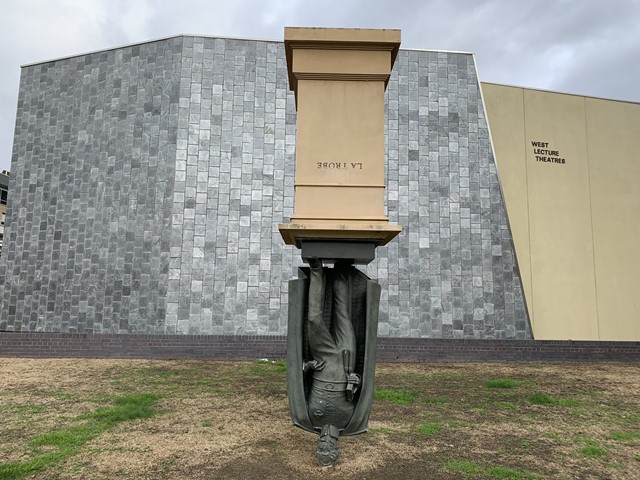
Fibreglass, polyester resin, steel, polystyrene, polyurethane, sand, automotive lacquers, acrylic paint
Charles Robb graduated from the Victorian College of the Arts in 1993 and completed a Bachelor of Fine Arts (Honours) Queensland University of Technology in 2002. He has held solo exhibitions featuring works from his ongoing sculptural self-portraiture project in Canberra, Brisbane, Perth and Melbourne.
The inverted monument, Landmark, pays homage to Victoria's first lieutenant-governor, Charles Joseph La Trobe. Historically viewed as an ineffectual leader, due mainly to his failure to deal adequately with the demands of the fledgling settlement and the issues emerging on the gold fields, La Trobe was an enlightened gentleman who believed strongly in the merits of education, the arts and a cultured civic society.
Landmark is based on traditional commemorative sculptures commonly found in public spaces, which honor heroes and those who have made significant contributions to society. Robb seeks to challenge the merit of such monuments in a contemporary society and a modern city by inverting this full scale statue, calling into question the relevance and authority of this predominantly European visual language. The inversion also makes comment on the fact that at the time of its creation, Landmark, was the only monument in Victoria which commemorated La Trobe, a man of immense significance in the development of Melbourne.
#2 Murri Totems by Reko Rennie (2012)
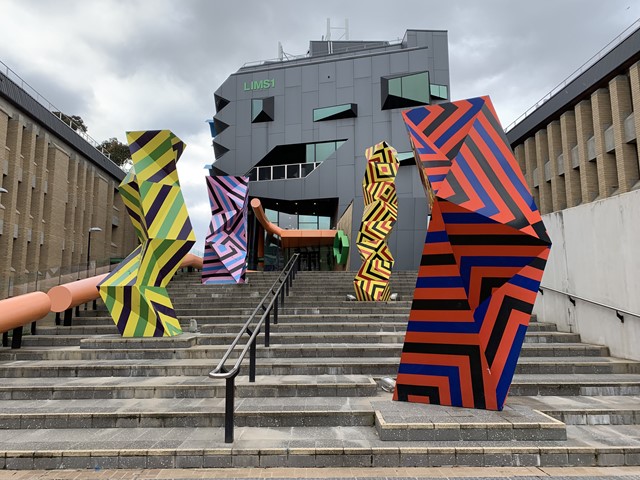
Aluminium, enamel paint, four structures
Reko Rennie is an indigenous man of Kamilaroi ancestry. An interdisciplinary artist Rennie explores his indigenous identity using an array of contemporary mediums including painting, sculpture, video and installation. He uses his practice as a means to provoke discussion about indigenous culture and identity in contemporary urban environments.
Murri Totems consists of four 4.5m vertical structures, which look like modern day ceremonial poles. Each vertical structure has been designed utilising the five platonic solids (icosahedron, octahedron, star tetrahedron, hexahedron and dodecahedron) considered to be the building blocks of nature within the canon of western science and philosophy. Each structure has been painted with the Murri design, a traditional indigenous diamond shaped pattern, handed down for use to Rennie by his father and grandfather. As such the work brings together the western world's understanding of the building blocks of nature with those of the indigenous world. The work is also a celebration of indigenous identity both past and present: present evident in Rennie's use of bright "spray-can-like" colours which pays homage to his urban upbringing and his artistic education as a street artist, the past represented by the traditional indigenous pattern.
#3 Untitled by Allen David (1966)
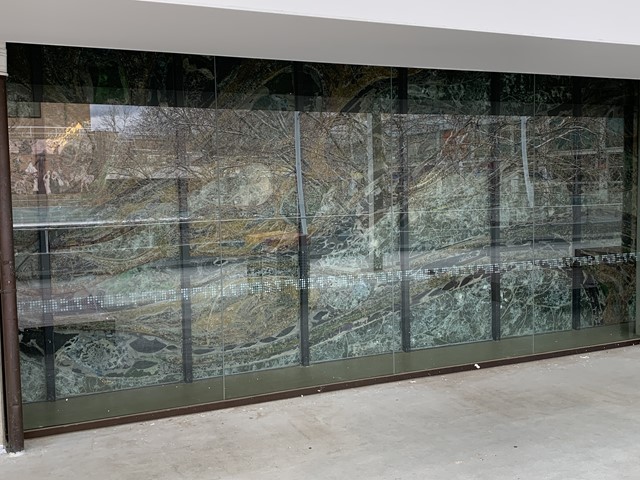
Laminated glass, coloured glass, gold leaf, metal 9 panels
#4 Rock Fall by Diego Latella (1978)
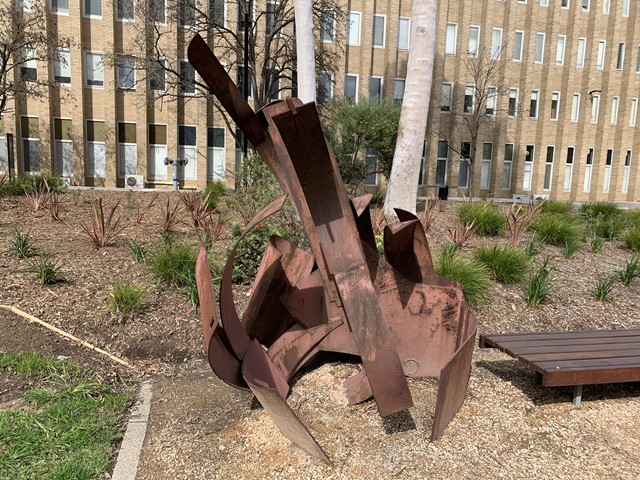
Steel
Diego Latella is a painter, sculptor, printmaker and teacher who studied in Sydney, New York and Italy. Best known for his minimal sculptures, his first solo show was in Sydney in 1973. He has also participated in a number of important group exhibitions including the Mildura Sculpture Triennial in 1978 and Perspecta at the Art Gallery of New South Wales in 1983.
Latella's work draws inspiration from both natural and urban environments. With a particular passion for the Italian and Australian landscapes, he expoles beauty and brutality in the transformation of the environment as brought about by both natural processes and human intervention.
Rock Fall captures a sudden shift in the landscape, freezing the fall of rocks and tracing their downward trajectory in ribbons of steel. Amid the chaos of individual paths of flight, the sculptural form also moves as a mass, lurching in a common direction, feeling itself on the verge of falling on its side. The work's rusted surface treatment evokes the slow transformative powers of nature as a counterpoint to the rapid destruction embodied in the sudden collapse of rock. Likewise, the work's industrial material raises questions about the similarities and differences in natural and human induced environmental change.
#5 Dante's Divine Comedy by Bart Sanciolo (1980-1983)
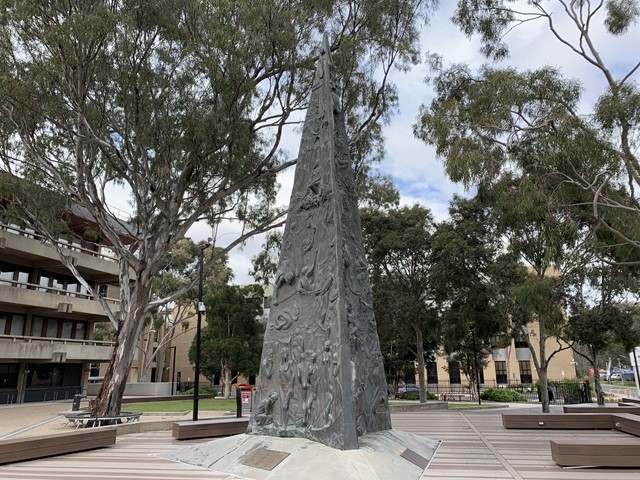
Bronze. Gift of the Italian Community to the People of Australia. Presented 1987.
Bart Sanciolo studied art and design at Preston Institute of Technology before graduating with an Associate Diploma of Fine Art Sculpture from RMIT in 1976. Dante's Divine Comedy was his first major commission in public art. He ha since completed numerous commissions and held numerous solo and group exhibitions.
Dante's Divine Comedy is a tribute to the early 14th century literary msterpiece by Dante Alighieri, regarded as a powerful and enduring symbol of European culture and civilisation, and precursor of modern political and scientific language. This complex, pyramid-like structure in bronze represents selected themes and events from Dante's imaginary journey through Inforno, Purgatorio and Paradiso. Led by Roman poet Virgil in rough chronological order from the base upwards on three individual panels, the sculpture is meant to be viewed in the round. Sanciolo explores universal themes and the realms of human emotion and expression through figurative and abstracted forms and motifs in relief.
Completed in 1983, the work was installed in the science precinct of the University's Bundoora campus in 1986. The cost of the sculpture, including the engineering design and installation, was donated by members of the Italian community. La Trobe University became custodian of the sculpture on behalf of the People of Australia when it was presented as a 150th Anniversary Gift of the Italian Community of Victoria to the People of Australia at the official unveiling by the Governor of Victoria in March 1987. It was classified by the National Trust in 1994.
#6 3 x 5 x 3 by Janusz Kuzbicki (2006)
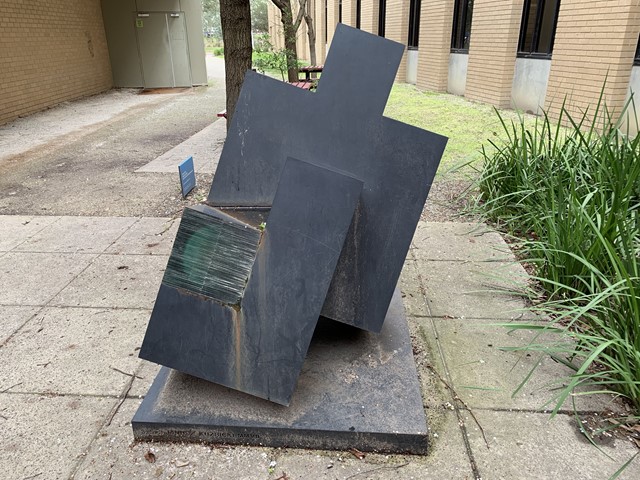
Steel and glass
Janusz Kuzbicki was born in Koszalin, Poland. He began his art training in Poland, but left before he graduated in order to avoid compulsory military service. He migrated to France, where he continued his art training for two years at the Fondation de Coubertin, before migrating to Australia in 1980 and settling in Melbourne. He established a professional art practice in painting, sculpture and ecclesiastical and architectural stained glass. His major international commissions include the Centenary of Australian Federation stained glass window for St. George's Chapel, Windsor Castle, England. His work also forms part of St. Patrick's Cathedral and St. Paul's Cathedral, Melbourne and St. Patrick's Catholic Cathedral in Ballarat.
3 x 5 x 3 is described by the artist as "an intellectual idea, an aesthetic experiment". The work presents the visual tensions between the contrasting materials of steel and glass, presented within precariously tilted planes, to elicit in the viewer the more philosophical and elusive connections that can be explored between music, mathematics and tectonic form movement. In the construction of this sculpture Kuzbicki combines both painstaking mathematical calculation and his own personal intuition - two elements which he nominates as the root of all arts and sciences. The juxtaposition between the black depths of the steel form and the light-capturing crescents which glint from the glass panes embedded within it evokes the wonder of space exploration, optical and geometrical marvels.
#7 Sofia by Herman Hohaus (1970)
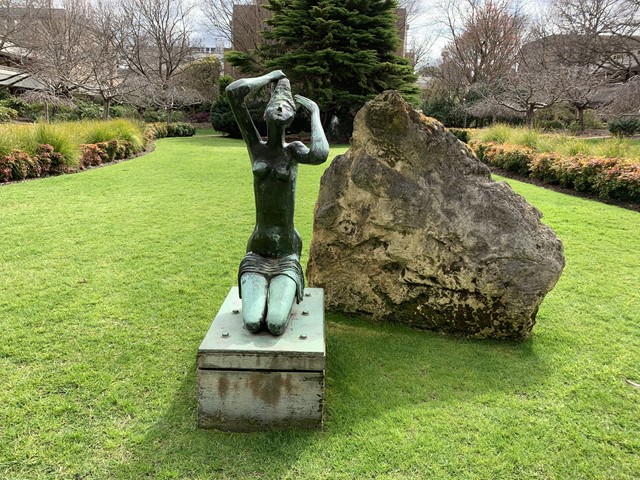
Cast bronze
Herman Hohaus, born in Silesia, Germany (now Poland) in 1920 before migrating to Australia in 1954, studied sculpture at the School of Applied Art, Bad Warmbrunn Silesia in the late 1930's. He primarily worked in the classical European tradition of carving in wood and stone as well as the technique of bronze casting. Rejecting the emerging formalism and schematic imagery of modernist sculpture, he remained commtted to figurative naturalism creating expressive, high allegorical and often symbolic forms in an intimate, more diminutive scale.
Throughout his oeuvre Hohaus explored humanistic themes through inward-looking imagery and motifs, such as the mother and child, the female offering food or flowers and solitary figures in moments of intense prayer, of which Sofia is a prime example.
Situated in the lawns of the former entrance to La Trobe University, Sofia was initially titled Kneeling Figure. In consultation with the artist, the sculpture was renamed Sofia and was officially unveiled at its present site in 1987. The name Sofia (or Sophia), meaning 'wisdom' in Greek, and 'holy wisdom' in Byzantine culture, has acquired various spellings and derivatives in more recent times, as has a particular association with Victoria's first Lieutenant Governor Charles Joseph La Trobe whose wife's first name was Sophie. With its new name, Hohaus's figure could be regarded as a sculptural metaphor for the pursuit of knowledge in a place of learning.
#8 The Four Seasons by Leonard French (1978)
Glass - Installed west to east: Winter, Spring, Summer, Autumn
#9 Chrysalid by Phil Price (2014)
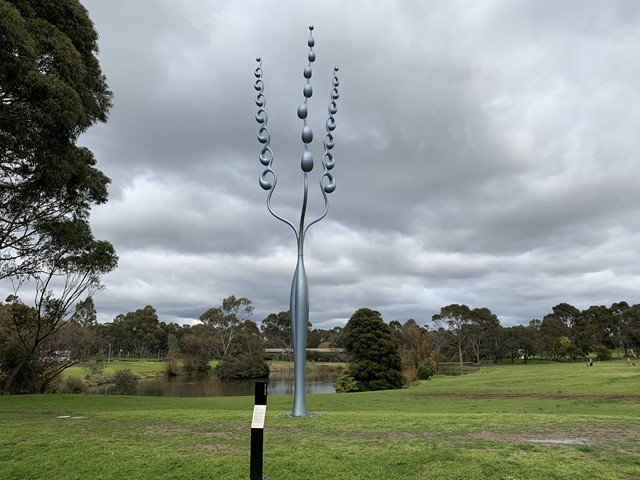
Carbon fibre, industrial paint, stainless steel, metal bearings
Phil Price studied sculpture at the University of Canterbury in Christchurch, New Zealand and is regarded for his large-scale wind-activated kinetic sculptures. He has many public and private commissions, internationally and throughout New Zealand and Australia, including Sculpture Parks and sculpture survey shows.
Chrysalid references the 1955 John Wyndham novel The Chrysalids set in post-apocalyptic, frontier farming own where inhabitants believe they must preserve 'absolute normality'.
The evocative frond-like arms of Price's work creates a speculative fiction between something organic in its essence and futuristic in its manoeuvres. The fronds respond to the touch of air, creating movement that is both simple and complex as it twists and turns, while remaining firmly grounded by its smooth elongated trunk.
Referencing a mobile with its free-moving parts that never come in contact with each other, Chrysalid demonstrates the artist's blend of material innovation with aesthetic design, offering a complexity of effortless movement through the implementation of technological means.
#10 Group of Boulders by Inge King (1970-1971)
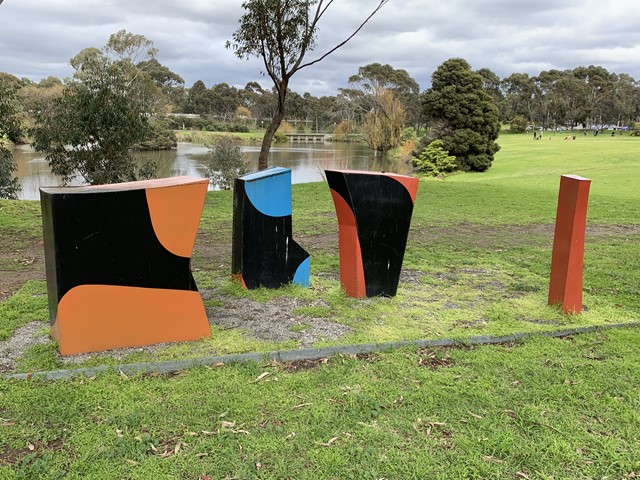
Metal and coloured paint four forms
Inge King studied at the Berlin Academy from 1937-38, the Royal Academy in London in 1940 and the Glasgow School of Art from 1941-43, before settling in Melbourne in 1951. A leading exponent of non-figurative sculpture in Australia, King's sophisticated and monumental works forged from steel can be found in significant public spaces throughout the country. Her most well-known work, Forward Surge (1972), graces the lawn outside the Victorian Arts Centre in Melbourne.
Group of Boulders is a part of a broader series that King started in 1967. It is inspired by the coastal landscape of Albany in Western Australia where King was teaching at the time. Long walks along the rugged coast brought her into contact with massive boulders washed by the sea. It was an interest in balance that informed these works, inspired by the way huge forms could be encountered perched atop tiny rocks, perplexingly held in place. Four separate forms compose this work. Like others from this series, abstracted rectilinear forms stand in place of the precariously balanced rocks observed in the landscape. Upright and top heavy, the relationships between the sculptural objects is enhanced by their surface treatment, with an arrangement of stylised painted shapes creating a further level of imbalance and compositional tension in the work.
#11 Anthology of Echoes by Peter Dingli (c.1975)
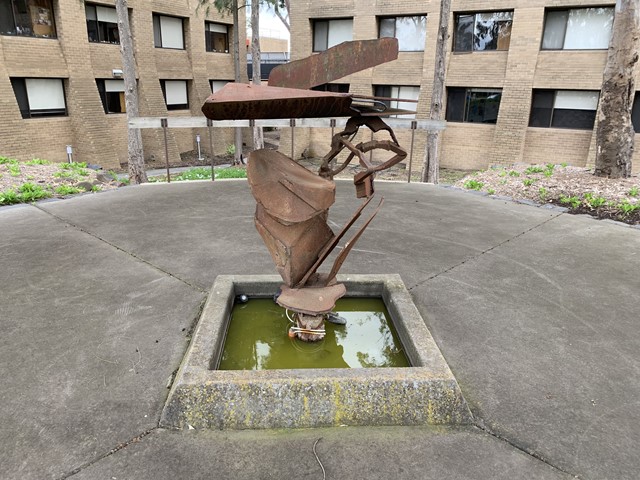
Forged and welded steel
Note: located more north east than shown on the map (next to Union Drive)
Peter Dingli graduated from art school in 1985 having studied at Prahran's Faculty of Art & Design, Victoria College under well-known sculptor and educator David Wilson (whose work Gateway is part of La Trobe University's Art Collection). Wilson had been part of the avant garde of the 1970's when the conventions of sculpture were being seriously questioned. The legacy of this experimentation enabled the following generation of sculptors to practise sculptural techniques with renewed enthusiasm.
Dingli's welded steel sculpture Anthology of Echoes reflects a return to the organic after the de-constructionist and formalist experiments of the 1970's. Although the title hints that the work is of an abstract nature, there remains the suggestion of a vestigial figure. Dingli used forging, welding and cutting, to exploit the expressive qualities of the medium, creating a variety of surfaces and shapes: curved and straight, smooth and rough. Aesthetic formalism and an element of abstraction are still present, however not at the expense of the expressive qualities of the medium or the imprint of the artist's hand.
Anthology of Echoes is installed at the University's Jolimont site (named after the house of Victoria's first Lieutenant Governor Charles Joseph La Trobe) which was frequently accessed by the general public as a viewing platform from which to observe the construction of the Bundoora campus.
#12 Gateway by David Wilson (1975)
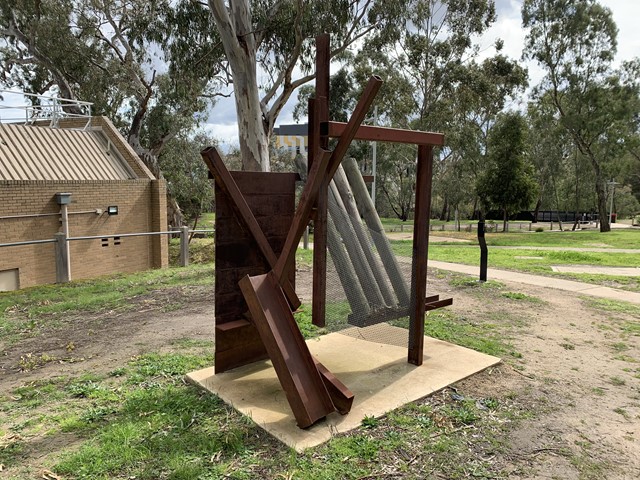
Steel, timber
David Wilson's early works were made in plastics and various mixed media before he began working in welded sleet. These welded steel forms strongly showed the influence of British sculptor Anthony Caro in their cool, formal, aesthetic quality. In the early 1970's Wilson created works which consisted of apparently randomly arranged elements placed on the ground.
Through the early and mid seventies, artists continued to grapple with the question of what defined sculpture. Wilson's response was to adhere to a formalist approach that did not concern itself with social relevance but instead composition and aesthetics.
The work Gateway is constructed entirely of materials that could be described as 'natural'. Yet they are industrial materials, that is, commercially treated and modified treated pine, galvanised mesh and steel girders. There is no evidence of the sculptor modelling. Wilson distances himself from the act of creation, eliminating any evidence of his role in the making of the work. Various construction techniques are employed including welding, bolting and gluing. Significantly, he places the work directly on the floor, removing the base and pedestal, continuing a revolution which began in the sixties. The title, Gateway, appears to refer to something concrete and easily associated with the materials from which the work is made. However, this is undercut by the work itself which defies reading as any kind of door or gateway with its strong diagonals and multiple possible viewing angles.
#13 Dialogue of Circles by Inge King (1976)
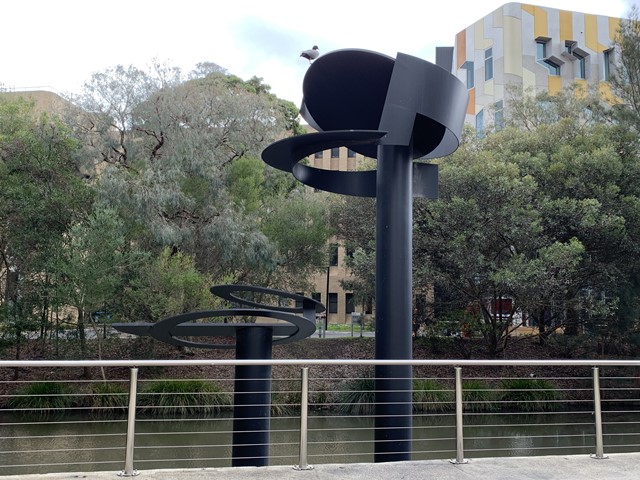
Welded steel, paint
Inge King trained in the traditional techniques of wood and stone carving in Berlin and Glasgow, and made a decisive shift away from figurative naturalism to abstraction early in her formative years. Renowned for her monumental abstract works in welded steel, King was at the forefront in the development of modern sculpture in Australia. She has held nearly 30 solo exhibitions, including major surveys, and has participated in over 60 group shows and has completed many public commissions.
During the 1970's King completed many monumental site-specific commissions for architectural and urban settings. Dialogue of Circles, one such commission, is the back-drop to the University's open-air moat theatre. The towering work consists of two steel columns rising from the water that support various interrelating circular forms, visually echoing its circular surroundings. The flattened metal plates are cut out and assembled with geometric logic and technical precision. The work represents King's own minimalist style of the 1970's that infers a degree of symbolism, where she sought simplicity and clarity of expression while exploring the rhythmic and gestural potential of geometric devices. The maquette for this work has been included in several exhibitions and is now part of the La Trobe University Art Collection.
#14 Ceremonial Post by Unknown (1991)
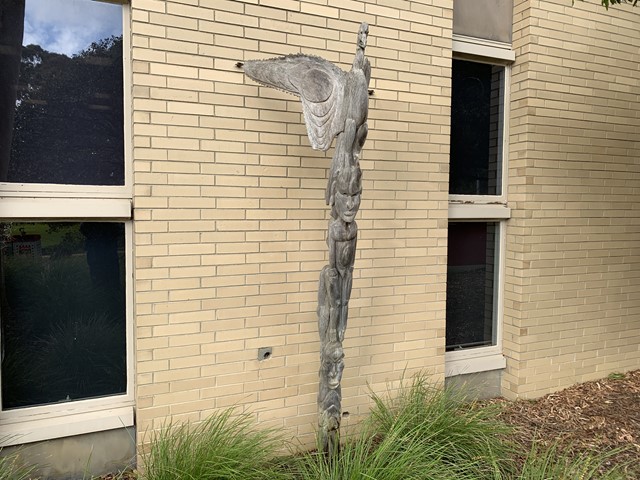
Pagwi, Middle Sepik Province, PNG wood
The Sepik River has been described as the 'Nile of Oceania'. At over 1,100 kilometres in length it winds its way through Papua New Guinea in a north-easterly direction. Along its banks, and those of the tributaries that feed into it, live a great number of culturally diverse groups. Trade and intercommunication between these groups has produced a wealth of artistic style and in some cases 'a diffusion' of styles.
La Trobe University is fortunate to hold an extensive Ethnographic Collection established through major donations dating back to the late 1970's. The Collection includes artefacts from South Africa, Australia and Papua New Guinea, of which the Sepik region is well represented.
The Ceremonial Post - which adorns the front of Glenn College - is from the township of Pagwi, located in the Middle Sepik Region. Made from aquilla hard wood, the post features a sea eagle with spreading wings settled on the head of a free-standing man. Such ceremonial posts were often placed at the front of the elaborate men's houses to either protect the building's occupants from the malevolent spirits or to warn the uninitiated against entering the sacred space.
#15 A New House Among the Stars by Jock Clutterbuck (1993)
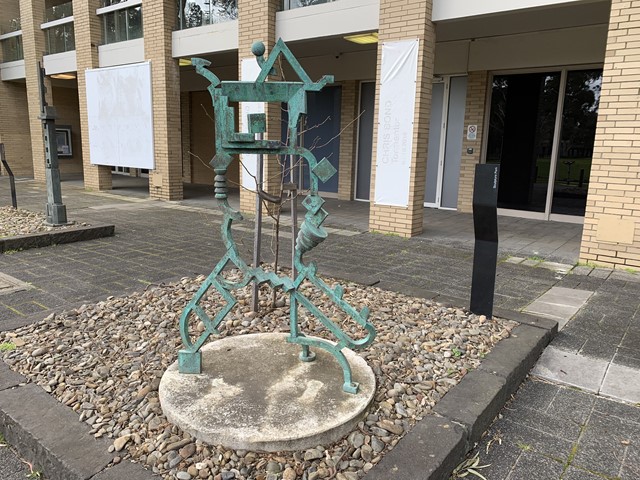
Cast, patinated bronze
Jock Clutterbuck studied sculpture and printmaking at the Royal Melbourne Institute of Technology, and held his first solo exhibition of etchings as an undergraduate student at the newly opened Crossley Gallery in 1966. By the late 1960's he was regarded as an accomplished printmaker and sculptor, winning the Australian Print Council Prize in 1969 and a special Victorian Government's Captain Cook Bi-Centenary Sculpture. Award in 1970 for Niagara.
A New House Among the Stars relates to a group of schematised forms which explore lineal relationships and the illusionary qualities of two and three dimensional space within a single form. Like a drawing in space, the linear cast metal bars and patterns of geometric shapes constantly direct the eye into and around the outer rims, so that the viewer begins to notice the multiple planes and perspectives, and spatial contradictions, contained within. Slanting diagonals and contorted arcs further divide and forshorten the inner voids, at once defining and neutralising the overall mass of the form. These elements add strong pictorial accents to the stylized house and planetary motifs perched on top which suggest a story and celestial themes. The surface of the work has been left unpolished and raw edges left exposed to highlight the distinctive texture of the polystyrene blocks from which the preparatory model was made. The patina applied to the bronze evokes the weathering of a relic in the landscape.
#16 Encounter by Inge King (1968)
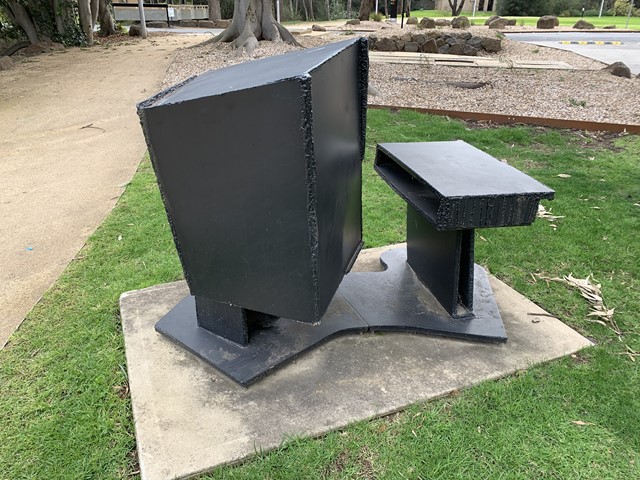
Bronzed, oxidised steel
Inge King trained in the traditional techniques of wood and stone carving in Berlin and Glasgow, and made a decisive shift away from figurative naturalism to abstraction early in her formative years. She settled in Australia in 1951, and with her technical expertise and knowledge of latest international trends in modern art, quickly established herself as a leading sculptor and exponent of the modern movement. In 1959 she became a founding member of the influential Centre Five group, whose aim was to raise the profile of contemporary sculpture in Australia through its promotion of abstraction, the use of new materials and techniques and commitment to art in architectural contexts and public spaces.
Encounter is from a period when Kings work became increasingly formalist and monumental as she explored the materials and process of welded assemblage, volumetric composition and the sculptural form in relation to the landscape. There is a rawness to the execution and a modern 'truth to materials' approach in the way King rough-cut sheets of steel into differently proportional plates, while the contrasting textures of the globular molten metal seams and smooth and incised planes and hollows accentuate the monumentality of the work. Patinated black, the two box-like forms are suggestive of rock formations and the austere features of modernist architectural design. The closely abutted forms also resemble a pair of heads or figures engaged, as the title suggests, in an encounter. The sense of communication also underlines the inherent symbolism and humanistic dimension in King's oeuvre.
#17 No. 661 Sentinel by Robert Klippel (1987)
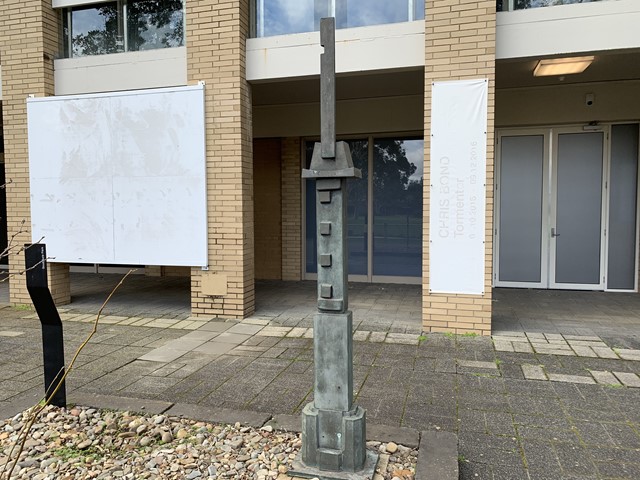
Bronze
Robert Klippel is considered one of the pre-eminent Australian sculptors of the twentieth century. Renowned for his welded junk-metal forms, he produced over 1,200 sculptures and 5,000 works on paper, and worked in a variety of natural and found materials using modernist techniques of collage and assemblage. He was fascinated with the inner structures and mechanisms of organic and mechanical forms, and explored the interrelationship between them in his quest for purely abstract and 'spiritually relevant' expression.
No. 661 Sentinel is from a period when Klippel sourced larger disused objects - often from shipbuilders' yards - to create his artworks. His wood and metal assemblages became simpler in shape and form and more suggestive of enclosed structures and rhythms. On one level this work has a distinctly modernist appearance. The various machine component parts used for making the original model for this cast bronze sculpture are bold and geometric. The dominant upward movement directs the eye along flat angular planes, symmetrical contours and defined spaces, enhancing the formal elements and monumentality of the slender form. But the modern, block like object is also suggestive of pure spirit. Its overall form brings to mind a primeval totemic statue. The sense of slow internal rhythms, interconnecting elements and emblematic nuances underline the spiritual dimension in the work. This is also reflected in the title of the piece, where the man-made, mechanistic object is transformed into a solitary guard - and is a kind of homage to the inherent spiritual possibilities in all things.
#18 Run for Your Life by Gillie and Marc Schattner (2014)
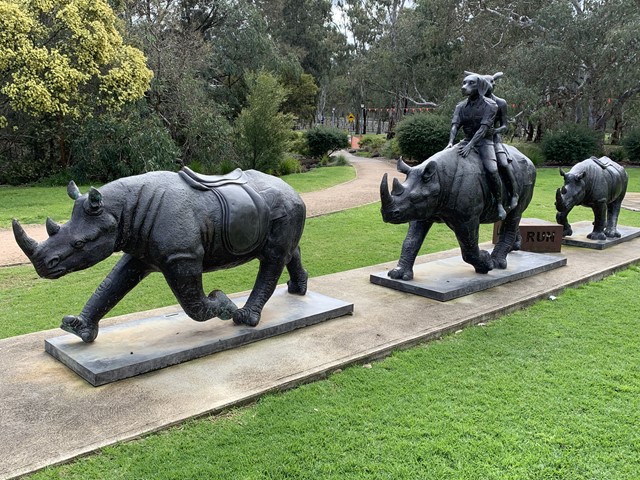
Bronze three forms
This wonderful sculpture 'Run for your life' has been gifted to La Trobe University by Wonderment Walk Victoria in 2015. Wonderment Walk Victoria believe that great societies are defined through their art, science and knowledge, which aligns with La Trobe University's own values and vision.
Created by internationally acclaimed, Australian artists Gillie and Marc, Run for your Life features three magnificent rhino sculptures that invite the public to be transported to the African savanna to be part of their run for freedom and life - with the subtle aim to raise public awareness of the plight of the now critically endangered rhino species. One rhino is ridden by Gillie and Marc's iconic hybrid dogman and rabbitgirl characters. The smaller rhinos invite you to hop on board, and experience these majestic creatures as they 'run for their life'!
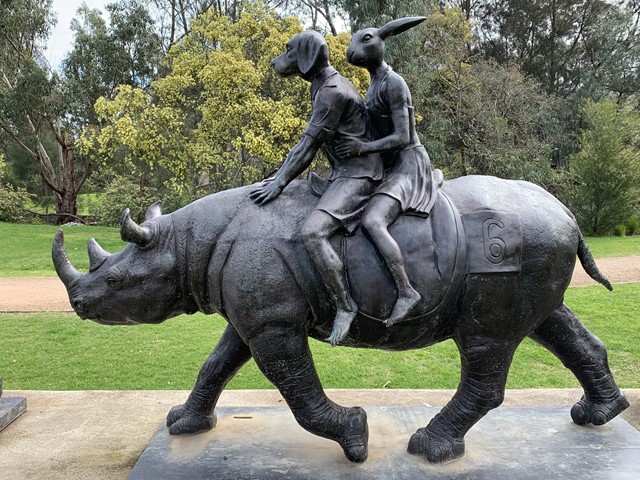
#19 Horned Night Walker by Heather B. Swann (2003)
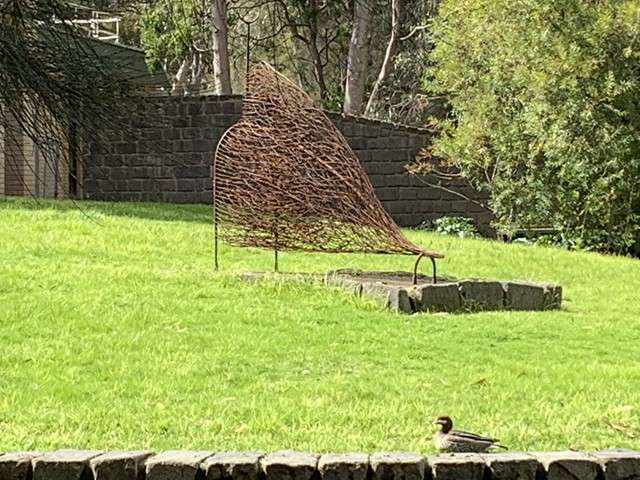
Steel
#20 Speak No Evil, See No Evil by Michael Nicholls (c. 1989)
Waxed Australian hardwood
#21 Hermitage by Karen Ward (2001)
Hardwood, industrial fittings
Additional artwork at the Bundoora campus of the University which are not part of the official sculpture trail include:
Angel Blue by Annette Hall (1987) which is located next to the pond west of #6.

Film History mural on the southern side of the Agora (south of #3)

Photos:
Location
La Trobe University, Melbourne Campus, Cnr Plenty Road and Kingsbury Drive, Bundoora 3086 View Map
✆ (03) 9479 2111
Email Enquiry
Web Links
→ Download Sculpture park map and brochure (PDF 1MB)








